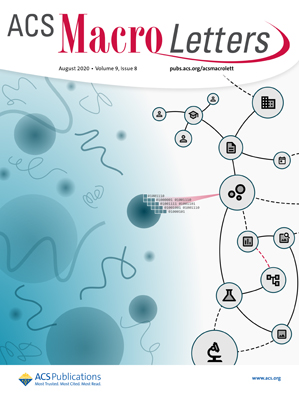棕褐色黑色素对基质金属蛋白酶局部失活的影响
IF 5.1
Q1 POLYMER SCIENCE
引用次数: 0
摘要
基质金属蛋白酶(Matrix metalloproteinases, MMPs)是一类依赖锌的酶,可降解细胞外基质,在伤口愈合和组织重塑中发挥重要作用。然而,MMPs的长期过度表达与慢性伤口环境有关。已提出局部停用MMPs的治疗方法,以改善未愈合的慢性伤口的预后。在这封信中,深褐色黑色素,一种天然的生物色素,探索MMPs失活,通过锌离子的螯合。黑色素具有与各种金属离子结合的化学官能团,我们证明这些官能团可以用于MMPs的失活。研究人员检测了黑色素对锌离子的选择性,以及使与慢性伤口相关的MMPs (MMP-1、MMP-2和MMP-9)失活的能力,并通过模拟未愈合伤口环境的体外功能组织试验证明了黑色素在伤口愈合中的潜在应用。这是首次证明使用黑色素使MMP失活。本文章由计算机程序翻译,如有差异,请以英文原文为准。

Sepia Melanin for the Local Deactivation of Matrix Metalloproteinases
Matrix metalloproteinases (MMPs) are a family of zinc-dependent enzymes that degrade the extracellular matrix and play essential functions in wound healing and tissue remodeling. However, the long-term overexpression of MMPs is associated with a chronic wound environment. Treatments that locally deactivate MMPs have been proposed to improve the outcomes of nonhealing chronic wounds. In this Letter, sepia melanin, a natural biopigment, is explored for the deactivation of MMPs, through chelation of zinc ions. Melanins have chemical functional groups to bind to various metal ions, which we demonstrate can be exploited for the deactivation of MMPs. Melanin’s selectivity for zinc ions, and ability to deactivate MMPs that are associated with chronic wounds (MMP-1, MMP-2, and MMP-9) are examined, and its potential application in wound healing is demonstrated by functional in vitro tissue assays, mimicking the nonhealing wound environment. This is the first demonstration of the use of melanin for MMP deactivation.
求助全文
通过发布文献求助,成功后即可免费获取论文全文。
去求助
来源期刊
CiteScore
10.40
自引率
3.40%
发文量
209
审稿时长
1 months
期刊介绍:
ACS Macro Letters publishes research in all areas of contemporary soft matter science in which macromolecules play a key role, including nanotechnology, self-assembly, supramolecular chemistry, biomaterials, energy generation and storage, and renewable/sustainable materials. Submissions to ACS Macro Letters should justify clearly the rapid disclosure of the key elements of the study. The scope of the journal includes high-impact research of broad interest in all areas of polymer science and engineering, including cross-disciplinary research that interfaces with polymer science.
With the launch of ACS Macro Letters, all Communications that were formerly published in Macromolecules and Biomacromolecules will be published as Letters in ACS Macro Letters.

 求助内容:
求助内容: 应助结果提醒方式:
应助结果提醒方式:


